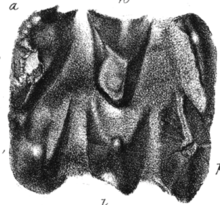Stereognathus
| Stereognathus | |
|---|---|

| |
| The postcanine tooth of Stereognathus ooliticus, from Owen 1857. | |
| Scientific classification | |
| Domain: | Eukaryota |
| Kingdom: | Animalia |
| Phylum: | Chordata |
| Clade: | Synapsida |
| Clade: | Therapsida |
| Clade: | Cynodontia |
| Family: | †Tritylodontidae |
| Genus: | †Stereognathus Charlesworth, 1854 |
| Type species | |
| Stereognathus ooliticus Charlesworth, 1854
| |
| Potential species | |
| |
| Synonyms | |
| |
Stereognathus is an extinct genus of tritylodontid cynodonts from the Middle Jurassic of the United Kingdom.[1] There is a single named species: S. ooliticus, named after the Great Oolite deposits of England. A second species, S. hebridicus, was named after the Hebrides in Scotland, where it was found; it was synonymized with S. ooliticus in 2017.[2]
Discovery and naming
S. ooliticus was the first tritylodontid species ever found, being described by Charlesworth in 1855[3] and later by Sir Richard Owen.[4] In 1972, S. hebridicus was named from several postcanine teeth recovered in Bathonian age deposits on the Isle of Skye in Scotland by palaeontologists R. J. G. Savage and Michael Waldman.[5] Despite being the first tritylodontid genus found and named, Stereognathus remains poorly represented, being known mainly from isolated molar teeth. There is, however, one holotype fragment of maxilla with three damaged molars, and a second fragment of maxilla with four sets of molar roots.
In 2017, Elsa Panciroli and colleagues found no points of variance between the anatomy of S. ooliticus and S. hebridicus, accounting for changes with growth, which makes S. hebridicus a junior synonym of S. ooliticus.[2] Also in 2017, Alexander Averianov and colleagues considered species of Polistodon, Xenocretosuchus, and Montirictus to be within the genus Stereognathus; they also retained S. hebridicus as a separate species.[6] However, this would mean Stereognathus persisted almost unchanged for over 60 million years across the whole of Eurasia, which would be very unusual. The issue remains unresolved.
References
- ^ Fossilworks. "Stereognathus." Retrieved from
- ^ a b Panciroli, E.; Walsh, S.; Fraser, N.C.; Brusatte, S.L.; Corfe, I. (2017). "A reassessment of the postcanine dentition and systematics of the tritylodontid Stereognathus (Cynodontia, Tritylodontidae, Mammaliamorpha), from the Middle Jurassic of the United Kingdom". Journal of Vertebrate Paleontology. 37 (5): e1351448. doi:10.1080/02724634.2017.1351448. hdl:20.500.11820/b140e841-1ad5-4cbe-aad7-7bb588f9f0c1.
- ^ Charlesworth, E 1855. Reprint British Association. 1854 Liverpool Abstracts, 80.
- ^ Owen, R 1856 On the affinity of Stereognathus ooliticus (Charlesworth) a mammal from the Oolitic slate of Stonesfield . Quarterly Journal of the Geological Society of London, 13, 1-11.
- ^ Waldman, M and Savage, R.J.G 1972 The first Jurassic mammal from Scotland. Journal of the Geological Society of London 128:119-125
- ^ Averianov, A.O.; Martin, T.; Lopatin, A.V.; Schultz, J.A.; Skutschas, P.P.; Rico, S.; Krasnolutskii, S.A. (2017). "A tritylodontid synapsid from the Middle Jurassic of Siberia and the taxonomy of derived tritylodontids". Journal of Vertebrate Paleontology. 37 (5): e1363767. doi:10.1080/02724634.2017.1363767.





